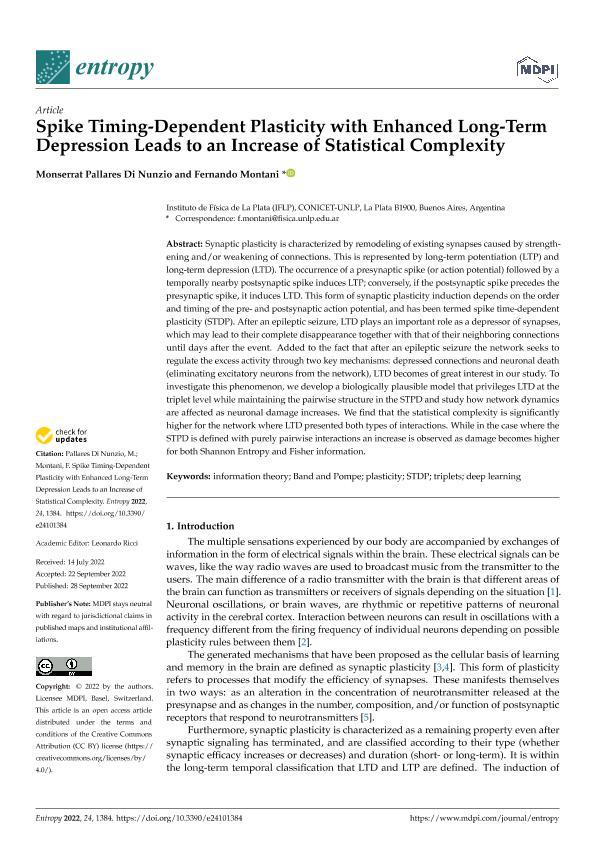Mostrar el registro sencillo del ítem
dc.contributor.author
Pallares Di Nunzio, Monserrat

dc.contributor.author
Montani, Fernando Fabián

dc.date.available
2023-08-03T12:25:48Z
dc.date.issued
2022-09-28
dc.identifier.citation
Pallares Di Nunzio, Monserrat; Montani, Fernando Fabián; Spike timing dependent plasticity with enhanced long-term depression leads to an increase of statistical complexity; Molecular Diversity Preservation International; Entropy; 24; 10; 28-9-2022; 1384-1406
dc.identifier.issn
1099-4300
dc.identifier.uri
http://hdl.handle.net/11336/206722
dc.description.abstract
Synaptic plasticity is characterized by remodeling of existing synapses caused by strengthening and/or weakening of connections. This is represented by long-term potentiation (LTP) and long-term depression (LTD). The occurrence of a presynaptic spike (or action potential) followed by a temporally nearby postsynaptic spike induces LTP; conversely, if the postsynaptic spike precedes the presynaptic spike, it induces LTD. This form of synaptic plasticity induction depends on the order and timing of the pre- and postsynaptic action potential, and has been termed spike time-dependent plasticity (STDP). After an epileptic seizure, LTD plays an important role as a depressor of synapses, which may lead to their complete disappearance together with that of their neighboring connections until days after the event. Added to the fact that after an epileptic seizure the network seeks to regulate the excess activity through two key mechanisms: depressed connections and neuronal death (eliminating excitatory neurons from the network), LTD becomes of great interest in our study. To investigate this phenomenon, we develop a biologically plausible model that privileges LTD at the triplet level while maintaining the pairwise structure in the STPD and study how network dynamics are affected as neuronal damage increases. We find that the statistical complexity is significantly higher for the network where LTD presented both types of interactions. While in the case where the STPD is defined with purely pairwise interactions an increase is observed as damage becomes higher for both Shannon Entropy and Fisher information.
dc.format
application/pdf
dc.language.iso
eng
dc.publisher
Molecular Diversity Preservation International

dc.rights
info:eu-repo/semantics/openAccess
dc.rights.uri
https://creativecommons.org/licenses/by-nc-sa/2.5/ar/
dc.subject
BAND AND POMPE
dc.subject
DEEP LEARNING
dc.subject
INFORMATION THEORY
dc.subject
PLASTICITY
dc.subject
STDP
dc.subject
TRIPLETS
dc.subject.classification
Otras Ciencias Físicas

dc.subject.classification
Ciencias Físicas

dc.subject.classification
CIENCIAS NATURALES Y EXACTAS

dc.title
Spike timing dependent plasticity with enhanced long-term depression leads to an increase of statistical complexity
dc.type
info:eu-repo/semantics/article
dc.type
info:ar-repo/semantics/artículo
dc.type
info:eu-repo/semantics/publishedVersion
dc.date.updated
2023-07-07T17:52:40Z
dc.journal.volume
24
dc.journal.number
10
dc.journal.pagination
1384-1406
dc.journal.pais
Suiza

dc.journal.ciudad
Basel
dc.description.fil
Fil: Pallares Di Nunzio, Monserrat. Consejo Nacional de Investigaciones Científicas y Técnicas. Centro Científico Tecnológico Conicet - La Plata. Instituto de Física La Plata. Universidad Nacional de La Plata. Facultad de Ciencias Exactas. Instituto de Física La Plata; Argentina
dc.description.fil
Fil: Montani, Fernando Fabián. Consejo Nacional de Investigaciones Científicas y Técnicas. Centro Científico Tecnológico Conicet - La Plata. Instituto de Física La Plata. Universidad Nacional de La Plata. Facultad de Ciencias Exactas. Instituto de Física La Plata; Argentina
dc.journal.title
Entropy

dc.relation.alternativeid
info:eu-repo/semantics/altIdentifier/url/https://www.mdpi.com/1099-4300/24/10/1384
dc.relation.alternativeid
info:eu-repo/semantics/altIdentifier/doi/https://doi.org/10.3390/e24101384
Archivos asociados
